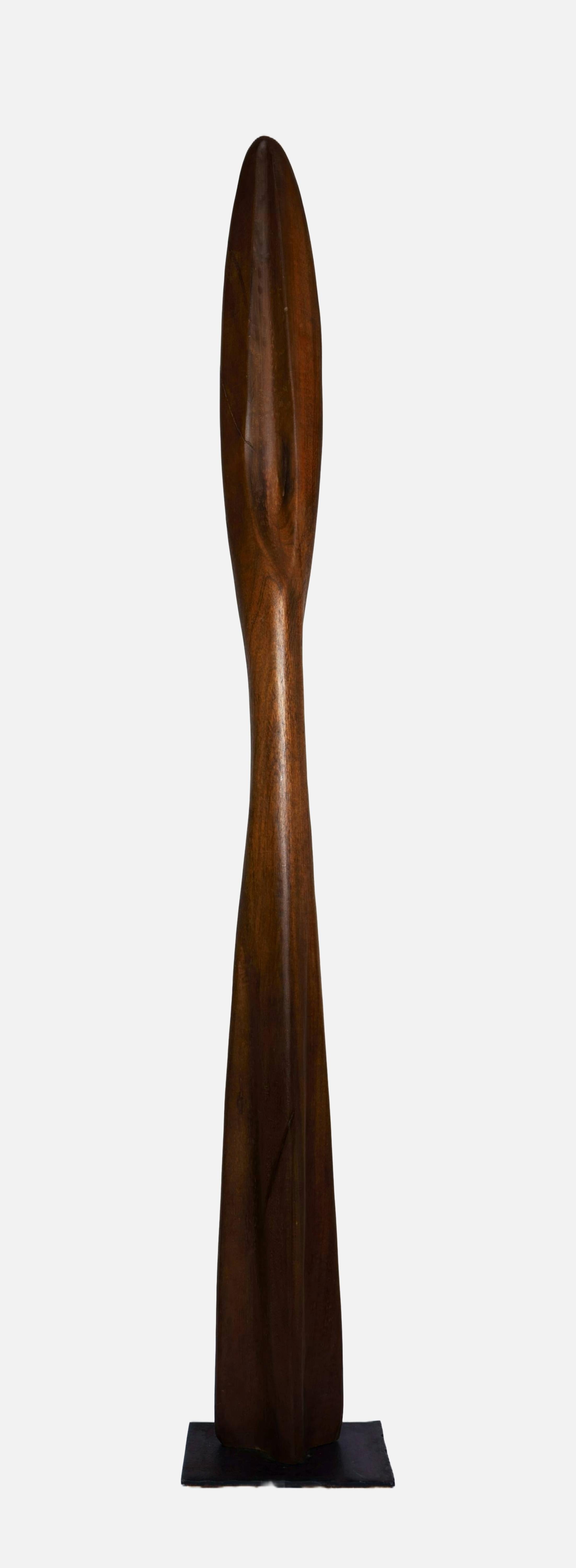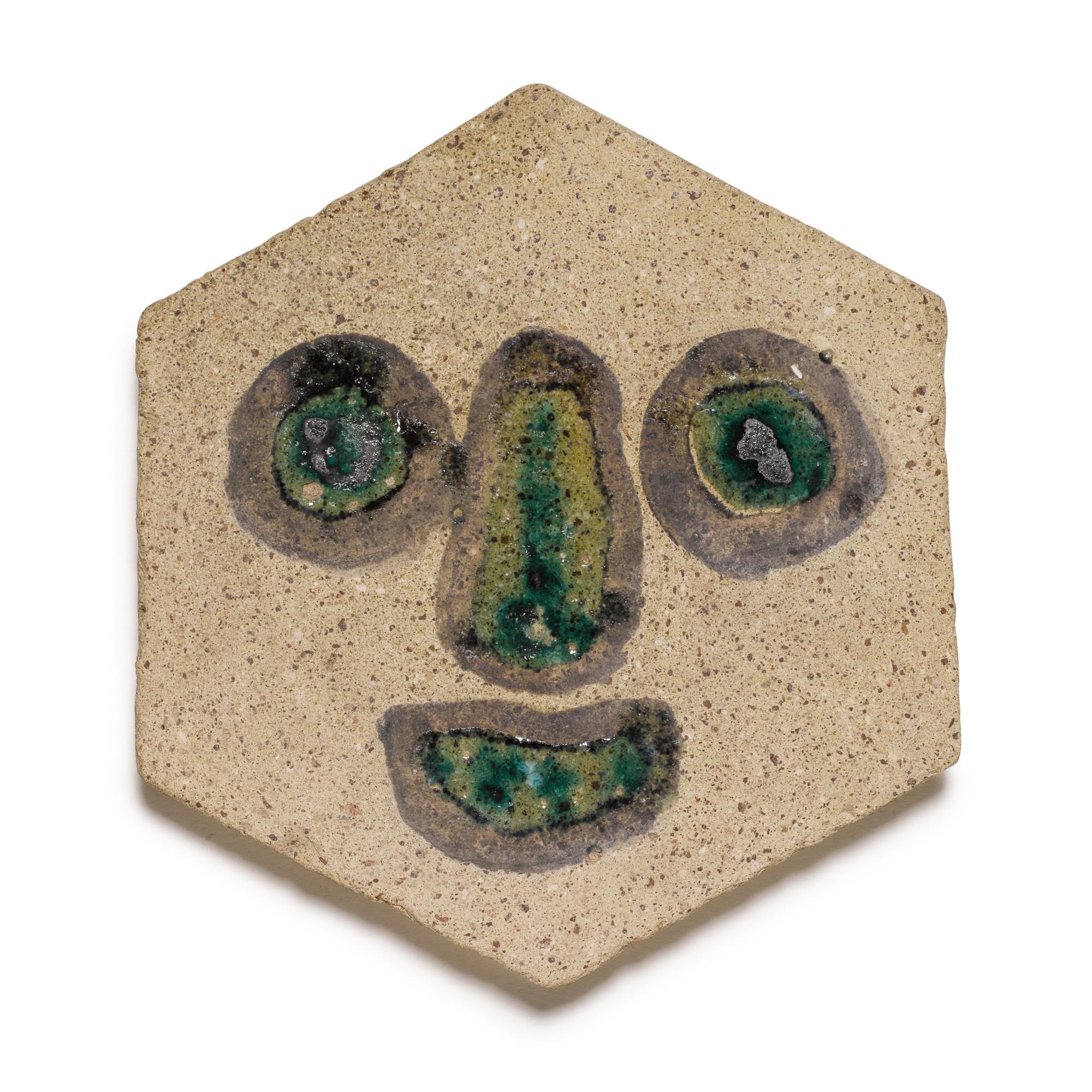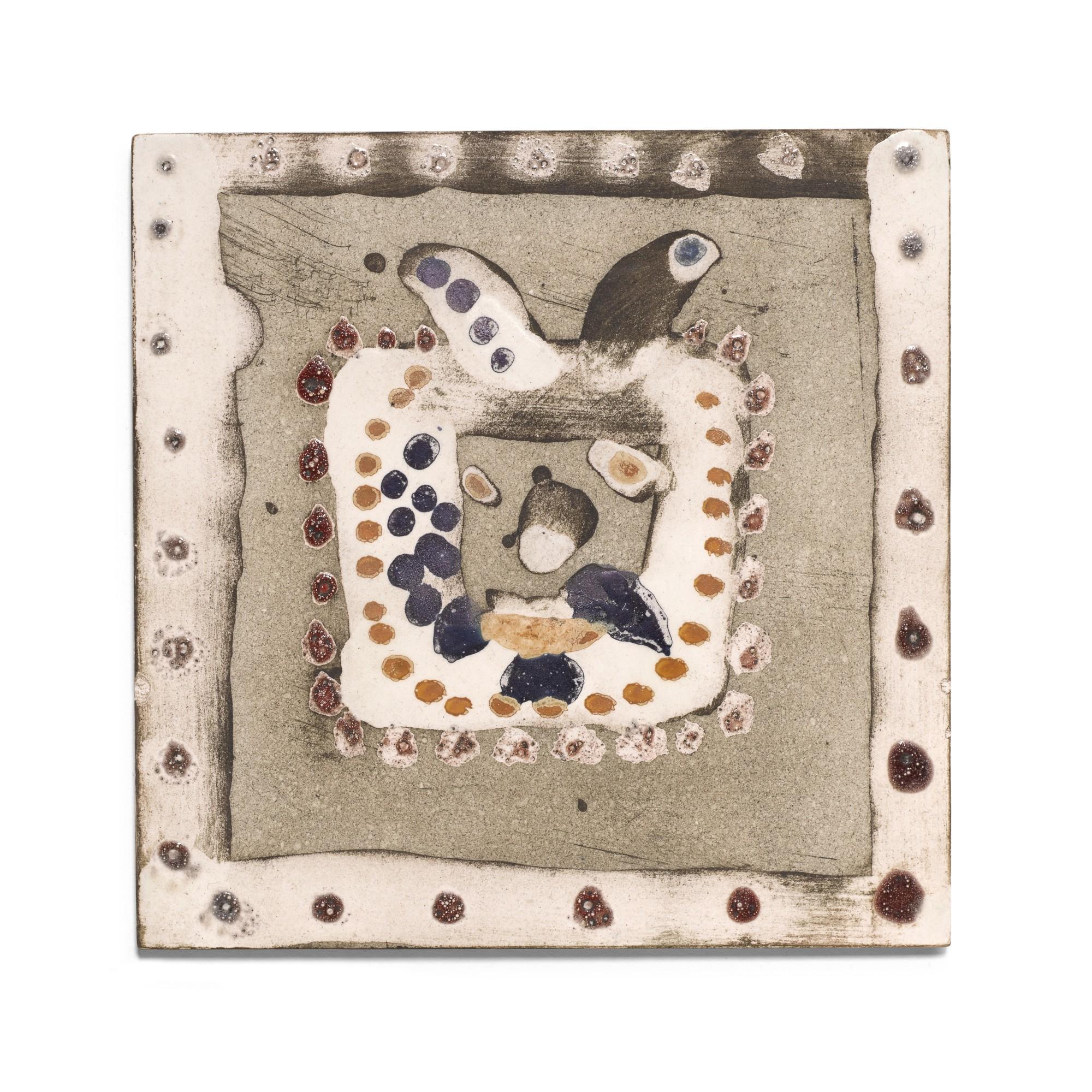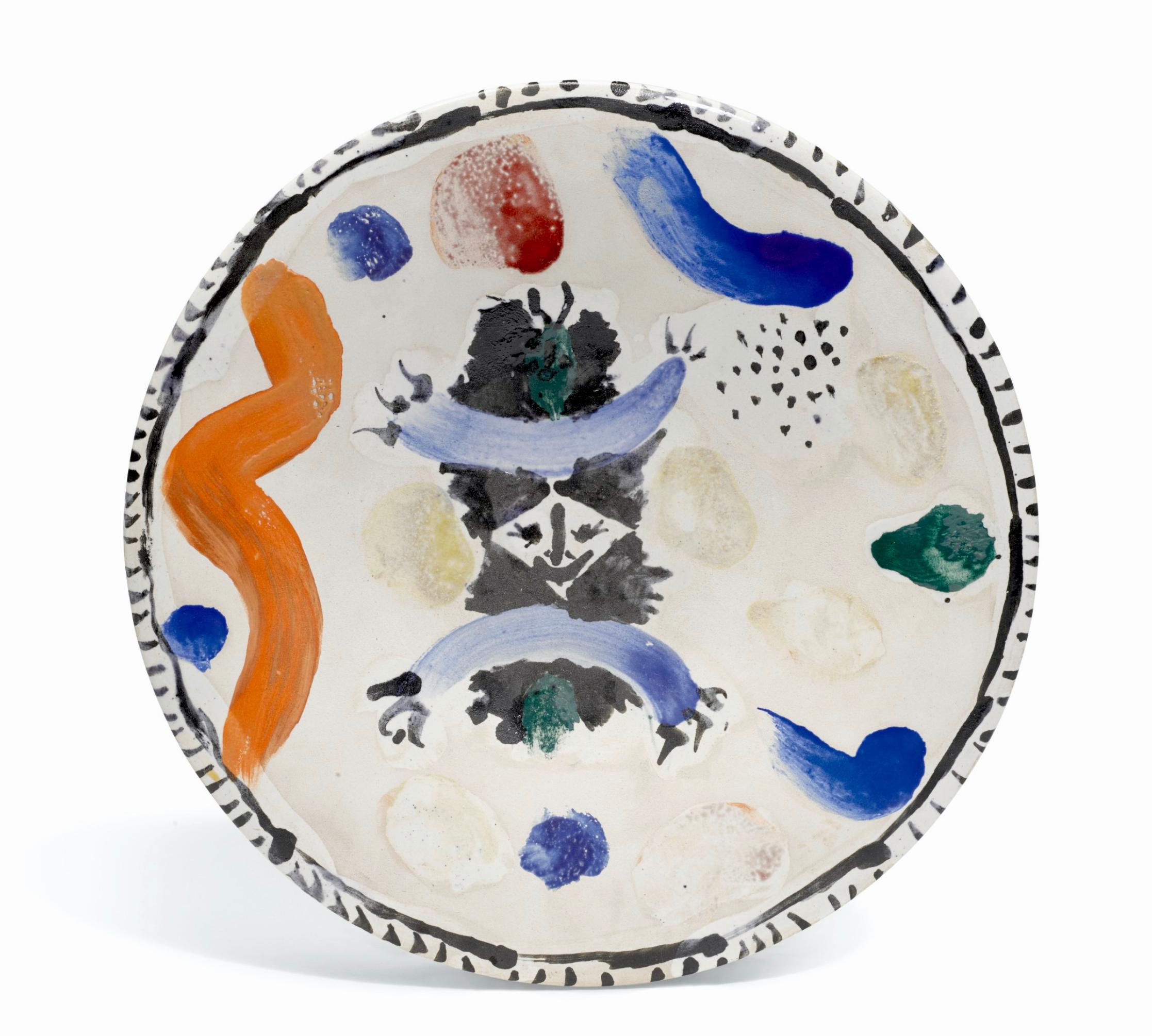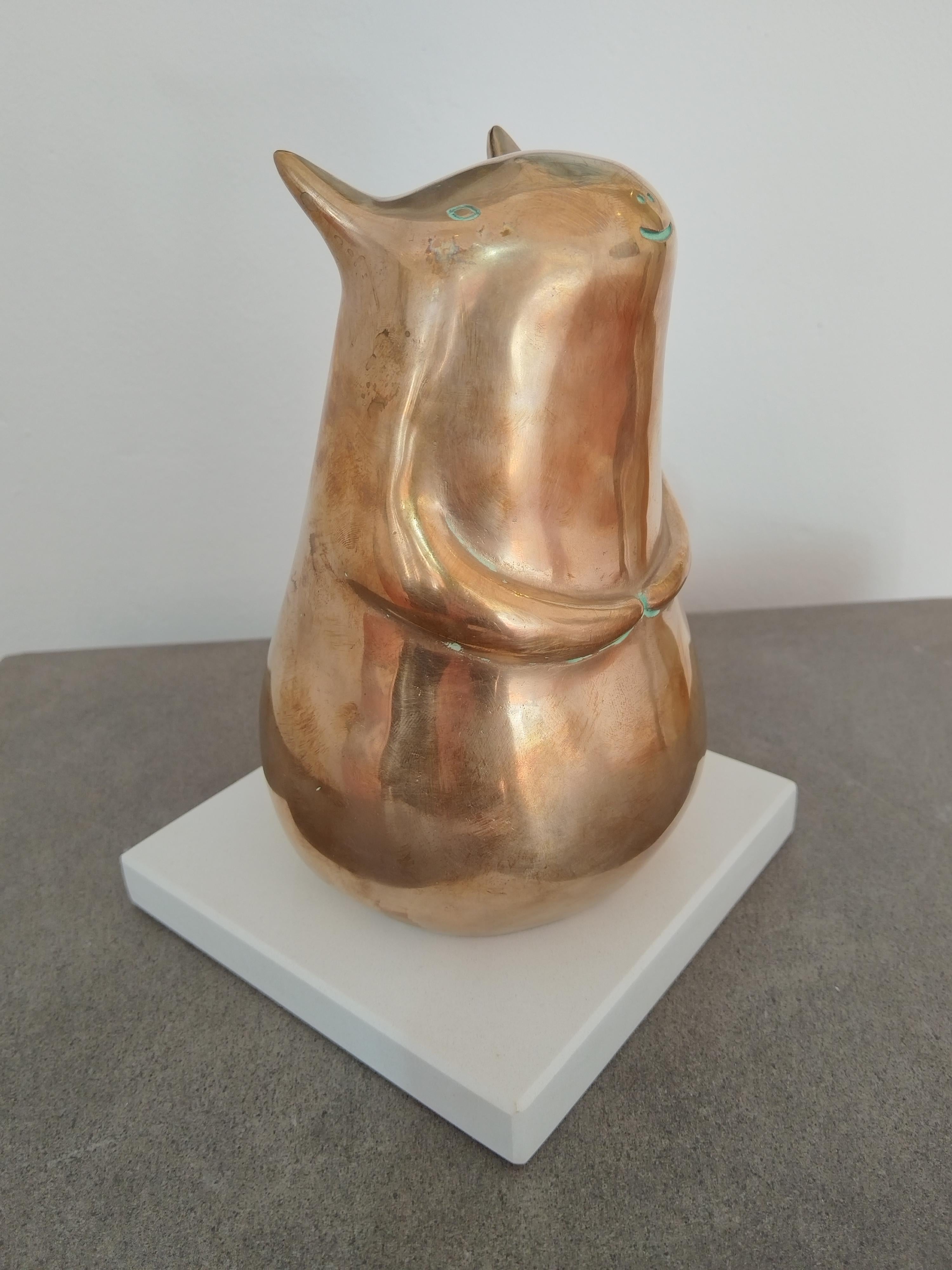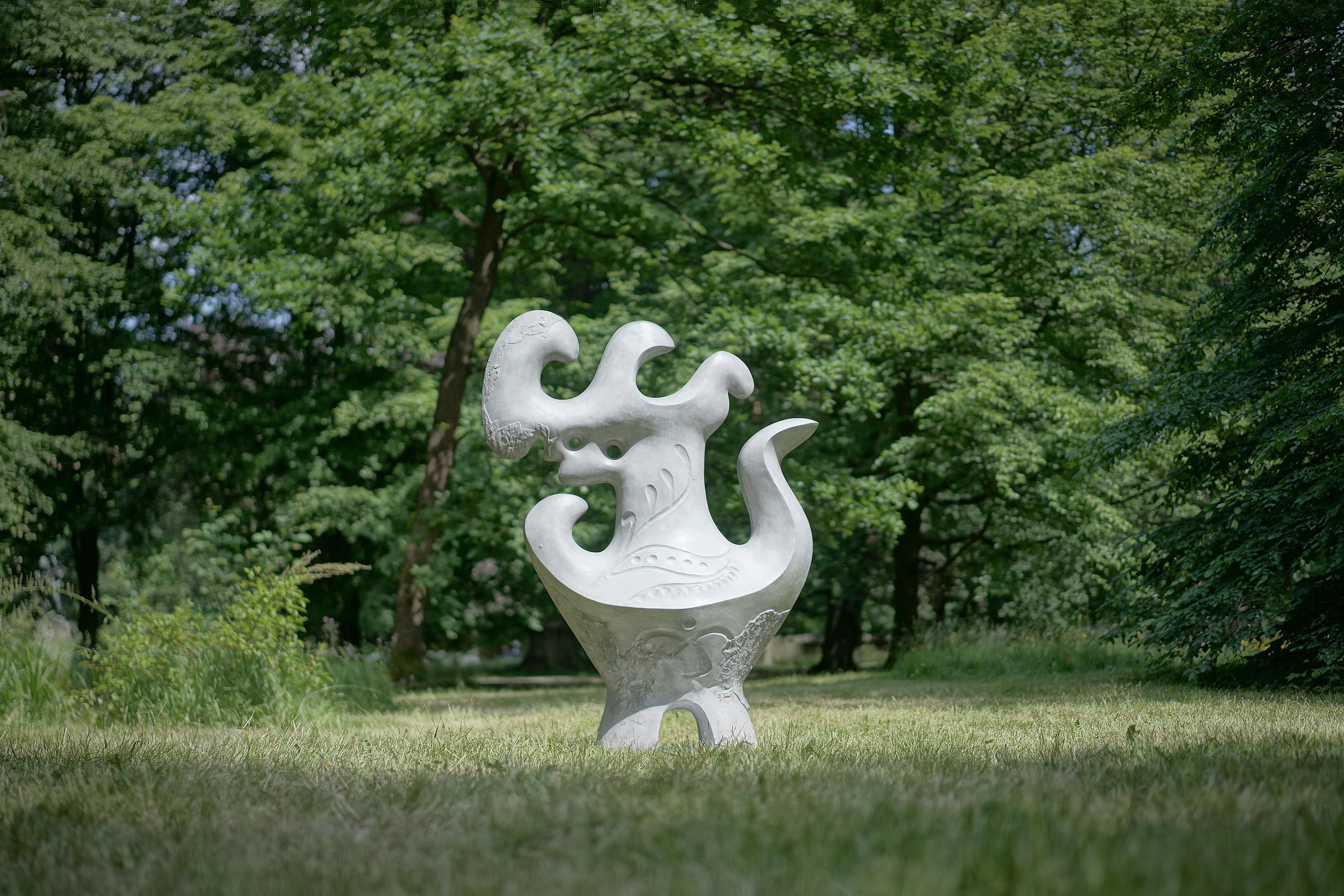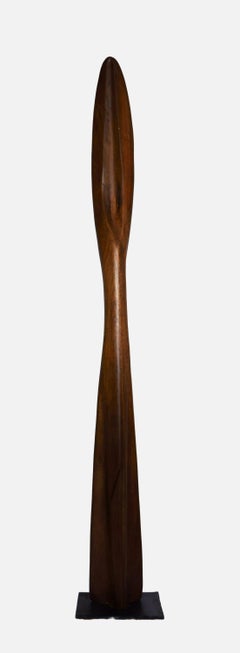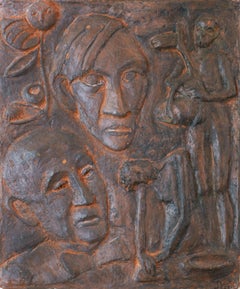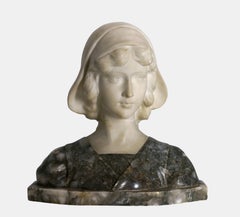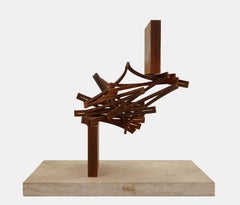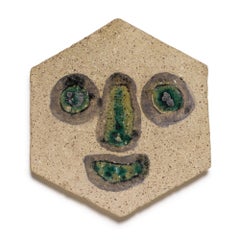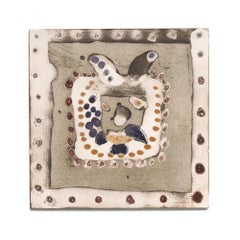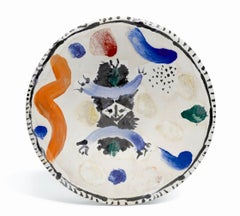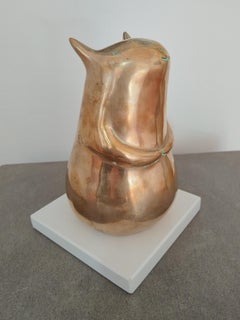Items Similar to Archaic Head / - Shaped Originality -
Want more images or videos?
Request additional images or videos from the seller
1 of 11
Paul DierkesArchaic Head / - Shaped Originality -1952
1952
About the Item
Paul Dierkes (1907 Cloppenburg - 1968 Berlin), Archaic Head. Limestone, 1952. 15 x 9 x 12 cm (without plinth), 19 x 10 x 11 cm (with plinth), monogrammed "PD" on the reverse.
- Shaped Originality -
At first glance, the limestone sculpture is recognizable as a human head, although it does not have a fully formed face. The nose, eyes, and ears are only hinted at, and yet they are so present that we immediately recognize them as features of a head, and we identify the bulge above the nose as the forehead, and the area below as the chin and neck, and we think we see the mouth and eyebrows, although they are not even hinted at.
We are looking at a kind of prototype of the head, although the head itself does not have the shape of a human head as it exists in nature. Nor is it the geometric shape of a circle or an oval, which would have an original and at the same time timeless character. Rather, we see a form shaped by a creator that cannot be resolved geometrically, although - especially when viewed from the side - it has a geometric rigor similar to that of Oskar Schlemmer's heads. Unlike Schlemmer's figures, however, Dierke's work reveals itself as something created: Traces of the shaving iron and the blows of the chisel are visible everywhere. The head is a handcrafted work of art that looks like an archaic artifact. The impression of originality therefore applies to both the representation and the production: the face only indicated goes beyond any concretely formulated physiognomy, so that a "primal individuality" reminiscent of the figures on Easter Island can be seen here, which appears to have been created with primitive tools by an original creative will.
The impression of originality is reinforced by the ancient material of the stone, on which the traces of carving are also perceived as traces of weathering, making the head appear like a mysterious archaeological artifact that reveals ever new aspects depending on how it is turned and how the light falls. The wooden base, which also presents its own material and on which the head rests freely, fits in with this.
About the arist
As the son of a stonemason, Paul Dierkes was familiar with stone from an early age. After an apprenticeship as a stonemason, he decided to explore this material artistically and become a sculptor. He first studied at the Königsberg Art Academy under Stanislaus Cauer. In 1931 he transferred to the Munich Academy and received a scholarship to Rome. He then settled in Berlin. His first solo exhibitions followed, including at the Ferdinand Möller Gallery in Berlin and the Augusteum in Oldenburg. Dierkes undertook study trips to Amsterdam, Prague, and Paris.
To avoid being drafted by the Nazis, he left Berlin and settled in Groß-Glienicke after the war, but moved back to West Berlin after the division of Germany.
In 1947, he was appointed to the Berlin Academy of Fine Arts and became a professor in 1948. For 20 years, until his death, he headed the Department of Stone and Wood. One of his students was Heinz Spilker.
Paul Dierkes is one of the protagonists who established modern sculpture in post-war Germany. He created archaic-looking forms that exude an aura of originality and, with their figurative allusions, also have a high symbolic value. The original effect gives his art a kinship with architecture, which led Dierkes to collaborate with Egon Eiermann, Peter Poelzig, and Sep Ruf. Many of his works characterize public spaces and demonstrate that Dierkes also understands sculpture as a monumental art that auratizes the respective location through a formed originality and thus develops a social relevance.
The aesthetic effect of sculptural originality often goes hand in hand with an emphasis on "being made," which underlines the craft aspect of the act of creation. For this reason, Paul Dierkes was also fond of woodcuts, which are related to the art of carving.
In 1954 Paul Dierkes was awarded the Art Prize of the City of Berlin.
Every idea creates something we suspected but did not know.
Paul Dierkes
The young Paul Dierkes already had the ability after his four-year apprenticeship as a stonemason to fathom the properties of each selected piece of wood and each stone and to figuratively transform individual natural processes of the grown organisms by means of his own working process.
Herbert Wolfgang Keiser
Bibliography
Herbert Wolfgang Keiser: Der Bildhauer Paul Dierkes, München, 1977.
GERMAN VERSION
Paul Dierkes (1907 Cloppenburg - 1968 Berlin), Archaischer Kopf. Kalkstein, 1952. 15 x 9 x 12 cm (ohne Sockel), 19 x 10 x 11 cm (mit Sockel), rückseitig mit „PD“ monogrammiert.
Exposé als PDF
- Geformte Ursprünglichkeit -
Die aus Kalkstein gehauene Skulptur ist auf den ersten Blick als menschlicher Kopf zu erkennen, obwohl er gar kein ausgeformtes Gesicht aufweist. Die Nase, die Augen und die Ohren sind einzig angedeutet und doch derart präsent, dass wir sie sofort als Merkmale eines Kopfes gewahren und die Wölbung über der Nase als Stirn und die Partie unter ihr als Kinn und Hals identifizieren und meinen, den Mund und die Augenbrauen zu sehen, obwohl diese nicht einmal angedeutet sind.
Wir betrachten eine Art Urform des Kopfes, wobei der Kopf selbst gar nicht die Form eines menschlichen Kopfes aufweist, wie er in natura beschaffen ist. Es handelt sich aber auch nicht um die geometrische Form eines Kreises oder Ovals, die einen ursprünglichen und zugleich zeitlosen Charakter aufweisen würde. Vielmehr sehen wir eine von einem Schöpfer geformte Form, die sich geometrisch nicht auflösen lässt, obwohl sie – insbesondere aus der Seitenansicht – eine geometrieähnliche Strenge aufweist, wodurch eine Ähnlichkeit mit den Köpfen Oskar Schlemmers gegeben ist. Im Gegensatz zu den Figuren Schlemmers gibt sich das Werk Dierkes aber als etwas Geschaffenes zu erkennen: Überall sind Spuren des Scharriereisens und Schläge der Meißel sichtbar. Der Kopf ist ein handwerklich gemachtes Kunstwerk, das wie ein archaisches Artefakt erscheint. Die Ursprünglichkeitswirkung betrifft folglich sowohl die Darstellung als auch die Herstellung: Das einzig angedeutete Gesicht reicht hinter jede konkret ausformulierte Physiognomie zurück, so dass hier eine an die Figuren der Osterinsel gemahnende ‚Ur-Individualität‘ vor Augen steht, die anmutet, als ob sie mit primitiven Werkzeugen von einem ursprünglichen Gestaltungswillen geschaffen worden wäre.
Der Eindruck der Ursprünglichkeit wird durch das uralte Material Stein verstärkt, auf dem die Bearbeitungsspuren zugleich als Spuren der Verwitterung wahrgenommen werden, wodurch der Kopf wie ein geheimnisvolles archäologisches Artefakt wirkt, das je nach Drehung und Lichteinfall immer neue Aspekte offenbart. Dazu passt der ebenfalls sein eigenes Material präsentierende Holzsockel, auf dem der Kopf freibeweglich aufliegt.
zum Künstler
Als Sohn eines Steinmetzen war Paul Dierkes von Kindesbeinen an mit dem Werkstoff Stein vertraut. Nach einer Steinmetzlehre entschied er sich, dieses Material auch künstlerisch zu erschließen und Bildhauer zu werden. Zunächst studierte er an der Kunstakademie Königsberg bei Stanislaus Cauer. 1931 wechselte er an die Münchner Akademie und erhielt dort ein Romstipendium. Anschließend fand er in Berlin seinen Lebensmittelpunkt. Erste Einzelausstellungen folgten, unter anderem in der Berliner Galerie Ferdinand Möller und dem Augusteum in Oldenburg. Dierkes unternahm Studienreise nach Amsterdam, Prag und Paris.
Um der Einberufung unter den Nationalsozialisten zu entgehen, verließ er Berlin und wurde nach Kriegsende in Groß-Glienicke sesshaft, zog nach der Teilung Deutschlands jedoch wieder nach West-Berlin.
1947 wurde er an die Berliner Hochschule für Bildende Künste berufen und 1948 zum Professor ernannt. Bis zu seinem Tod leitete er 20 Jahre den Fachbereich für Stein und Holz. Einer seiner Meisterschüler war Heinz Spilker.
Paul Dierkes zählt zu den Protagnisten, die die moderne Skulptur im Nachkriegsdeutschland etabliert haben. Er schuf archaisch wirkende Formen, die eine Aura des Ursprünglichen entfalten und mit ihren figürlichen Allusionen zugleich eine hohe symbolische Valenz aufweisen. Durch die Ursprünglichkeitswirkung ist eine Verwandtschaft seiner Kunst mit der Architektur gegeben, die Dierkes dazu geführt hat, mit Egon Eiermann, Peter Poelzig und Sep Ruf zusammenzuarbeiten. Zahlreiche seiner Werke prägen den öffentlichen Raum und führen vor Augen, dass Dierkes Skulptur auch als monumentale Kunst versteht, die den jeweiligen Ort von einer geformten Ursprünglichkeit her auratisiert und auf diese Weise eine gesellschaftliche Relevanz entfaltet.
Die ästhetische Wirkung plastischer Ursprünglichkeit geht oftmals mit einer Betonung des ‚Gemacht-Sein‘ einher, womit der handwerkliche Aspekt des Schöpfungsaktes herausgestellt wird. Daher war Paul Dierkes auch dem der Schnitzkunst verwandten Holzschnitt zugetan.
1954 wurde Paul Dierkes mit dem Kunstpreis Stadt Berlin geehrt.
Mit jeder Idee wird etwas gestaltet, das wir ahnen, aber nicht wußten.
Paul Dierkes
Eigenschaften von jedem ausgewählten Stück Holz und jedem Stein zu ergründen und einzelnen Naturvorgänge der gewachsenen Organismen im übertragenen Sinne sich mittels eines eigenen Arbeitsprozesses anverwandeln zu können, solche Fähigkeiten sind bereits bei dem jungen Paul Dierkes nach vierjähriger Handwerkslehre als Steinmetz vorhanden gewesen.
Herbert Wolfgang Keiser
Literatur
Herbert Wolfgang Keiser: Der Bildhauer Paul Dierkes, München, 1977.

About the Seller
5.0
Gold Seller
Premium sellers maintaining a 4.3+ rating and 24-hour response times
Established in 2014
1stDibs seller since 2023
16 sales on 1stDibs
Typical response time: 6 hours
- ShippingRetrieving quote...Shipping from: Berlin, Germany
- Return Policy
Authenticity Guarantee
In the unlikely event there’s an issue with an item’s authenticity, contact us within 1 year for a full refund. DetailsMoney-Back Guarantee
If your item is not as described, is damaged in transit, or does not arrive, contact us within 7 days for a full refund. Details24-Hour Cancellation
You have a 24-hour grace period in which to reconsider your purchase, with no questions asked.Vetted Professional Sellers
Our world-class sellers must adhere to strict standards for service and quality, maintaining the integrity of our listings.Price-Match Guarantee
If you find that a seller listed the same item for a lower price elsewhere, we’ll match it.Trusted Global Delivery
Our best-in-class carrier network provides specialized shipping options worldwide, including custom delivery.More From This Seller
View AllVegetative Form / - Grown Art -
Located in Berlin, DE
Paul Dierkes (1907 Cloppenburg - 1968 Berlin), Vegetative Form. Mahogany, 1958. 142 x 16 x 10 cm (sculpture), 21 x 17.5 cm (base), monogrammed "PD" on the reverse.
- Grown Art -
...
Category
1950s Post-War Abstract Sculptures
Materials
Mahogany
$3,197 Sale Price
20% Off
Homage à Kahnweiler / - The Appearance of Genius-
Located in Berlin, DE
Irmgard Biernath (1905 Waldheim in Saxony - 1998 Mainz), Hommage à Kahnweiler, 1984. Terracotta relief, burnished red body, 43.5 x 38 cm, mounted on support plate, in wooden frame 57 x 49.5 cm, monogrammed "IB" at lower right.
- Isolated patina losses, but overall good condition, frame slightly bumped.
- The Appearance of Genius-
This homage to Daniel-Henry Kahnweiler shows the gallerist and art theorist as Pablo Picasso portrayed him in his lithographic portrait of 1957.
As an innovative Parisian gallery owner, Kahnweiler had exclusively represented Picasso since 1911, while Picasso had painted his famous portrait of Kahnweiler the previous year as a major work of Cubism. And it is Picasso who appears at the centre of Irmgard Biernath's image. Here, his face echoes the features of the self-portrait he painted in 1907 in the Prague National Gallery.
His eyes are wide open as he gazes into the distance, surrounded by the works of his artistic vision that have already taken shape. On the right is the bronze "Man with Sheep...
Category
1980s Contemporary Figurative Sculptures
Materials
Terracotta
$1,096 Sale Price
20% Off
Bust of a young woman / - Beauty of youth -
Located in Berlin, DE
Anonymous, Bust of a young woman, c. 1900, artificial marble and gray onyx marble. 37 cm (height) x 37 cm (width) x 22 cm (depth), weight 17.2 kg. Signed “GURRINI” on the reverse.
-...
Category
Early 1900s Realist Figurative Sculptures
Materials
Marble
$868 Sale Price
20% Off
Gradual Rotation / - Dynamic Tectonics -
Located in Berlin, DE
Thomas Röthel (*1969 Ansbach), Gradual Rotation, around 2005. Steel with rust patina mounted on stone plate. Overall dimensions: 38 cm (height) x 34 cm (width) x 27 cm (depth), weigh...
Category
Early 2000s Abstract Abstract Sculptures
Materials
Steel
Allegory of Progress / - The Driving Force of Inspiration -
Located in Berlin, DE
Ernest Rancoulet (1842-1918), Allegory of Progress, around 1890. Bronze-plated metal cast with cast terrain plinth mounted on a wooden base (6 cm high). 64.5 cm (total height) x 28 c...
Category
1890s Realist Figurative Sculptures
Materials
Metal
Spear Fighter / - The Fighter's Concentration -
Located in Berlin, DE
Ludwig Eisenberger (active in Berlin between 1895-1920), Spear Fighter, around 1910. Brown patinated bronze with residual gilding on a cast terrain plinth with marble base (8 cm high...
Category
1910s Realist Nude Sculptures
Materials
Bronze
You May Also Like
Visage, Picasso, 1950's, Unique work, sculpture, design, Frame, Portrait
By Pablo Picasso
Located in Geneva, CH
Visage, Picasso, 1950's, Unique work, sculpture, design, Frame, Portrait
Visage
Unique work
1957
Painted and partially glazed ceramic ; tomette
16.9 x 15.2 cm
Certificate of authent...
Category
1950s Post-War Figurative Sculptures
Materials
Ceramic
Tête de faune, Picasso, Tile, Ceramic, Sculpture, Design, Postwar, Mythological
By Pablo Picasso
Located in Geneva, CH
Tête de faune, Picasso, Tile,Ceramic,Sculpture, Design, Postwar, Mythological
Tête de faune
Unique work
circa 1968
Painted and partially glazed ceramic, square tile
15.2 x 15.2 cm
C...
Category
1960s Post-War Figurative Sculptures
Materials
Earthenware
Petit masque central, Pablo Picasso, 1960's, Unique, Design, Plate, Theater
By Pablo Picasso
Located in Geneva, CH
Petit masque central, Pablo Picasso, 1960's, Unique, Design, Plate, Theater
Petit masque central
Unique work
16.5.63
Painted and partially glazed ceramic
D. 25.4 cm / 9.8 in.
D. 33 ...
Category
1960s Post-War Abstract Sculptures
Materials
Ceramic, Earthenware
Limited Edition 12/12 Quirky Bronze Sculpture with Shiny Patina "Hello Creature"
Located in Cape Town, ZA
Edition number 12/12. A quirky sculpture with a shiny bronze finish, standing on a 17 x 17 cm white granite base.
Davies creates playful sculptures that celebrate the courage it tak...
Category
2010s Contemporary Figurative Sculptures
Materials
Granite, Bronze
Grey Amphora by Pavlína Kvita-Contemporary sculpture, futuristic abstract figure
By Pavlína Kvita
Located in Paris, FR
Grey Amphora is a glass fiber and reinforced concrete sculpture by Czech contemporary artist Pavlína Kvita, notable for its distinctive surface details—unusual within the artist’s br...
Category
2010s Contemporary Figurative Sculptures
Materials
Concrete
Concrete Head Unique Figurative Abstract Geometric Figure Grey In Stock 2024
By Thomas Junghans
Located in Utrecht, NL
Concrete Head Unique Figurative Abstract Geometric Figure Grey Contemporary In Stock
Concrete head is a figurative, abstract, geometric, figure, grey po...
Category
21st Century and Contemporary Contemporary Figurative Sculptures
Materials
Concrete
Recently Viewed
View AllMore Ways To Browse
Stone Head Sculpture
Wooden Sculpture Heads
Vintage Wooden Head
Stone Artifacts
Circle Stone Light
Thinker Wood Sculpture
Stone Carving Head
Plinth Stone Base
Limestone Head
Paul Moller
Wooden Art Plinth
Post Modern Plinth
Chisel Hand Tool
Worden Wood
Stone Carving Head
Limestone Head
Stone Artifacts
Circle Stone Light
